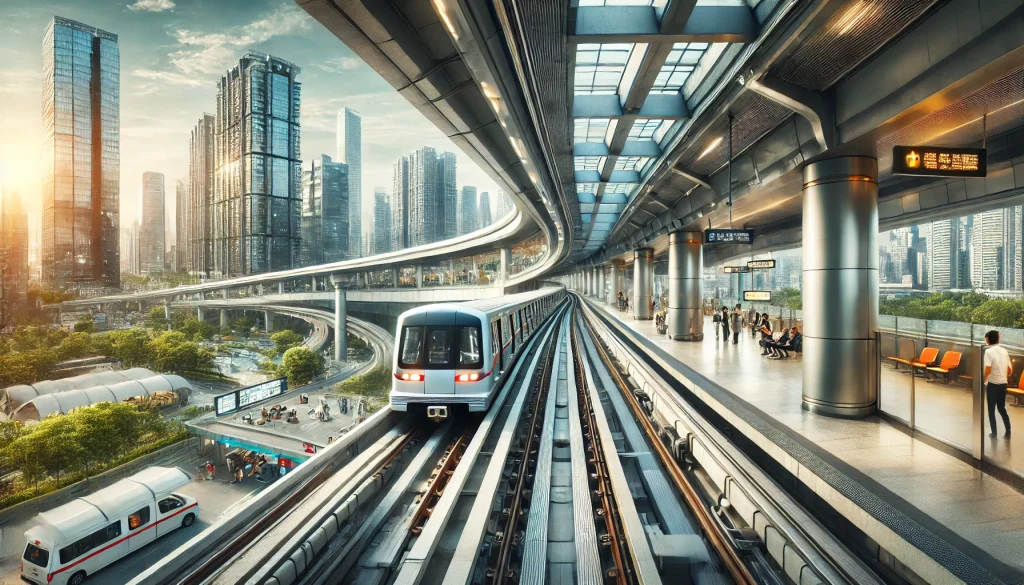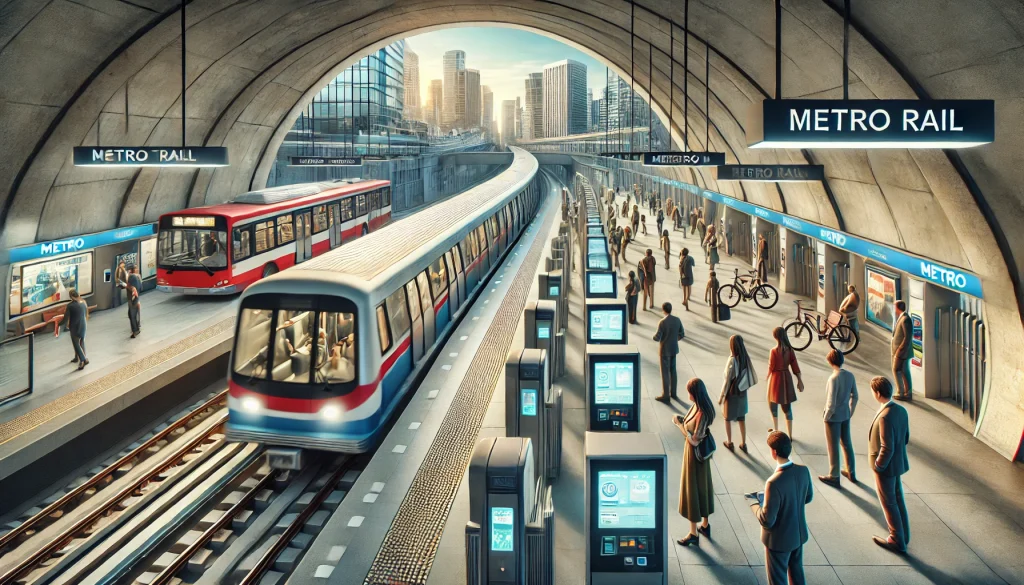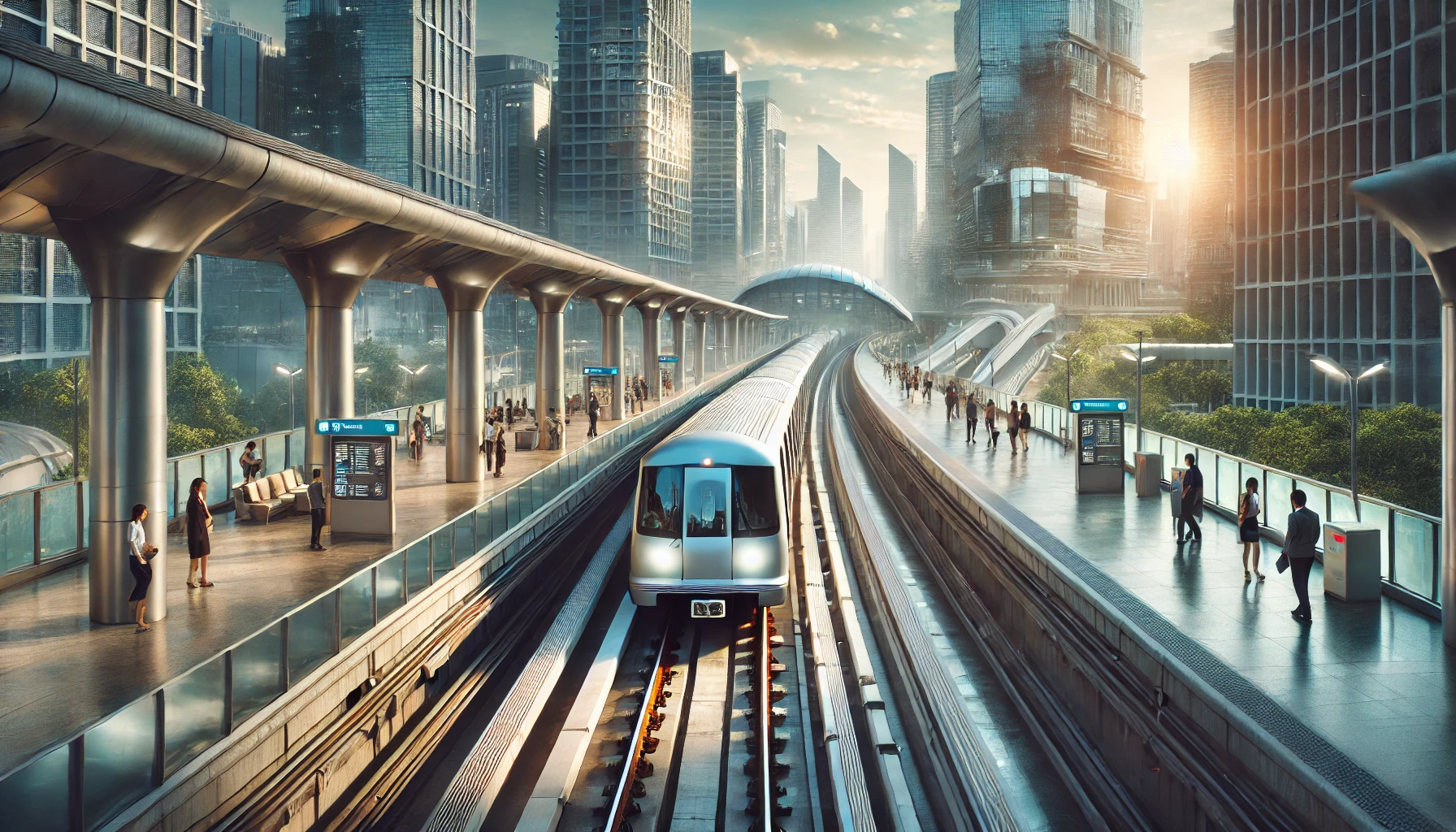
The metro rail is a modern public transportation system that runs on dedicated tracks, either underground or elevated, making travel faster and easier, especially in busy cities. Imagine being able to avoid traffic jams and long waits at bus stops. That’s exactly what the metro does. It helps people get to their destination quickly and efficiently, making it a popular choice for students, workers, and tourists.
Metro Rail Paragraph: Benefits, Features, and Importance for Class 6-12 Students

This article will show you why metro rail systems are so important. From how they reduce traffic on busy roads to how they make commuting more affordable and eco-friendly, you’ll see why metros are a key part of any modern city. Whether you’re writing a 150-word paragraph or a more detailed 300-word version, you’ll understand why these systems are becoming essential worldwide.
By the end of this, you’ll learn how the metro rail makes everyday commuting smoother, helps cut down on pollution, and provides an affordable way to travel around cities. You’ll also get to know about the advantages they bring in terms of time-saving and reducing road congestion. So, let’s dive into why metro rail systems matter so much!
Related: Price Hike
Metro Rail: A Public Transportation System
The metro rail is a type of public transportation system that runs on dedicated tracks, often underground or elevated, providing a fast and efficient way to travel. Unlike cars and buses that get stuck in traffic, metro trains have their own routes, making travel quicker and more reliable. For people living in busy cities, the metro rail is an essential part of daily life, offering a comfortable, eco-friendly, and affordable transportation option.
Metro Stations
Metro stations are the places where passengers board and exit the metro. These stations are usually located in key areas of the city, such as near schools, business districts, and shopping centers. The stations are built to accommodate large numbers of people, with wide platforms, ticket counters, and seating areas. In many cases, stations are equipped with escalators, elevators, and signage to make navigation easy for everyone, including those with special needs.
Metro Train
The metro train is the actual vehicle that carries passengers from one station to another. These trains are designed for comfort and efficiency, often featuring air-conditioning and ample seating. Unlike buses that stop frequently or cars that deal with traffic, the metro train runs on electricity, making it faster and more environmentally friendly. Metro trains are known for their quiet and smooth operation, making the commute much more pleasant than being stuck on a noisy, crowded bus.
Metro Route
Metro trains run on fixed routes, connecting different parts of a city in a straight line or loop. These routes are carefully planned to make sure passengers can get from one place to another as quickly as possible. Since metro trains don’t have to deal with traffic signals or crowded roads, they cover long distances in a short time. This makes the metro one of the most efficient ways to travel, especially in big cities where traffic jams are a daily hassle.
Ticketing System
The metro’s ticketing system is designed to be simple and convenient. Passengers can buy tickets or tokens at the station, or use a smart card that can be recharged with money. In many modern metro systems, passengers can also use mobile apps to purchase tickets, making the whole process faster. The ticketing system is usually automated, which reduces long lines and makes it easier for passengers to enter and exit the metro station without delays.
Speed and Efficiency
When it comes to speed and efficiency, the metro is hard to beat. Since metro trains run on dedicated tracks, they avoid the traffic jams and delays that are common with buses and cars. A metro train can cover a long distance in a short amount of time, making it ideal for people who need to get to work or school quickly. This speed and reliability make the metro the preferred choice for daily commuters in large cities.
Safety Features
Safety is a top priority for metro systems. To ensure passengers’ security, metro stations and trains are equipped with surveillance cameras (CCTV) and emergency alarms. There are also safety doors on platforms that prevent passengers from accidentally falling onto the tracks. Additionally, metro staff are trained to respond to emergencies quickly, making the metro one of the safest ways to travel. These features give passengers peace of mind, knowing that their commute is both safe and secure.
Urban Transport: Metro Rail’s Role in the Bigger Picture

Metro rail is a key part of urban transport, fitting into the broader system of public transportation that helps keep cities connected and moving. Alongside buses, taxis, and trams, the metro plays a vital role in making it easier for people to get around without relying on personal vehicles. It not only offers a faster and more efficient travel option but also helps improve the overall mobility of a city by working with other transportation systems.
Public Transportation
When you compare the metro to other forms of public transportation, like buses or taxis, it’s clear why the metro is often the preferred choice for daily commuters. While buses and taxis share the road with cars and face traffic jams, the metro runs on its own tracks, avoiding the delays caused by road congestion. Unlike taxis, which can be expensive for long distances, metro rail provides a more affordable option, especially for students and regular commuters. By working alongside buses and taxis, the metro rail ensures that people have a variety of options to reach their destinations in the most convenient way possible.
Reduced Traffic
One of the biggest advantages of metro rail systems is how they help reduce traffic on busy city roads. In big cities, traffic jams are a daily headache, with cars, buses, and motorbikes all fighting for space on overcrowded roads. Metro trains give people an alternative to driving their own cars, which means fewer vehicles on the road. This not only helps ease congestion but also shortens travel times for everyone. By offering a fast, reliable alternative to cars, the metro keeps traffic flowing and reduces the frustration of getting stuck in long lines of vehicles.
Environmental Impact
The metro rail system is also much better for the environment compared to traditional forms of transport. Since it runs on electricity, it doesn’t burn gasoline like buses or cars, which means it produces far fewer emissions. In fact, metro systems significantly reduce a city’s carbon footprint by cutting down the number of gas-powered vehicles on the roads. Additionally, with more people choosing the metro, the demand for petrol and diesel decreases, further reducing harmful emissions that contribute to air pollution. For cities looking to improve air quality and reduce their impact on the environment, expanding metro rail networks is a step in the right direction.
Commuting: How Metro Rail Makes Daily Travel Easier
For people who live in cities, commuting is part of everyday life. Whether it’s students heading to school, workers rushing to their offices, or tourists exploring the city, the metro rail has become one of the most reliable and efficient ways to get around. Metro systems are designed to handle large numbers of passengers each day, providing a convenient solution for urban mobility.
Daily Commute
Many people rely on the metro for their daily commute. Students use it to get to their schools or colleges, while office workers depend on it to avoid the hassle of road traffic. The metro’s fixed schedules and reliable service make it an essential mode of transport for those who need to get from one place to another quickly. With the metro, people can plan their travel times more accurately, knowing they won’t be stuck in unpredictable traffic jams like they would in a car or bus.
Comfort and Convenience
The metro is not just about speed—it’s also designed to provide a comfortable and clean environment for passengers. Most metro trains are equipped with air conditioning, comfortable seats, and adequate space for standing passengers. The stations are typically well-maintained, with clear signage, escalators, and elevators, making them easy to navigate. For long or short trips, passengers can enjoy a hassle-free journey in a metro, avoiding the bumpy roads and crowded conditions often associated with buses. The clean and well-organized atmosphere makes metro commuting a much more pleasant experience.
Affordable
One of the biggest reasons why people, especially students, prefer the metro is its affordability. Compared to taxis, which can be expensive, or personal vehicles, which require fuel and parking fees, the metro is a much cheaper alternative. For students on tight budgets, the low cost of metro tickets makes it an ideal option. Even regular commuters, who need to travel to work every day, find that using the metro saves them money while offering a reliable way to get around. This affordability ensures that the metro is accessible to everyone, from students and workers to tourists.
Infrastructure: The Backbone of Metro Rail Systems
Metro rail systems are not just convenient for daily commuters; they are a vital part of urban development and play a key role in modern city infrastructure. These systems are carefully planned and built to ensure cities can move large numbers of people quickly and efficiently. By avoiding the congested roads and running on dedicated tracks, metro systems help cities grow while reducing the strain on public roads and highways.
Metro Tracks
The secret behind the metro’s speed and efficiency lies in its dedicated tracks. Unlike buses or cars that have to share the road with other vehicles, metro trains run on their own tracks. These tracks are either built underground or elevated above the streets, keeping the metro free from the usual traffic jams. By having their own routes, metro trains can travel faster, making it easier for passengers to get to their destination on time. This also means metro trains don’t face the same delays caused by accidents or roadblocks, ensuring a smooth and reliable journey every time.
Underground and Elevated Sections
Metro systems often have both underground tunnels and elevated tracks to make the best use of available space, especially in crowded cities. In areas where space is tight, metro trains run underground, allowing the city to continue its regular activities above without interruption. On the other hand, elevated tracks are used when building underground might be too expensive or difficult. By using both underground and elevated sections, metro systems can operate in almost any environment, ensuring that people can travel across the city quickly, regardless of how crowded the streets might be.
Metro Construction
Building a metro system is a huge project that involves careful planning and a lot of work. Metro construction usually starts with mapping out the most important areas of the city where people need easy access, such as business centers, schools, and shopping districts. Once the routes are planned, construction teams work to build the tunnels, tracks, and stations that will make the metro network. Over time, these networks are often expanded to reach more areas, making public transportation accessible to more people. As cities grow, so do their metro systems, ensuring that the metro remains a critical part of urban infrastructure, connecting people to where they need to go.
Regional Metro Systems: City or Country-Specific Examples
Metro rail systems are becoming an essential part of urban transport worldwide, with cities in various countries building and expanding their networks to improve public transportation. Each metro system is unique, adapting to the needs of its city’s population. By connecting key areas and reducing travel time, these systems are transforming how people move within cities. Let’s take a closer look at some specific examples.
Dhaka Metro Rail
One of the most anticipated metro projects in South Asia is the Dhaka Metro Rail in Bangladesh. This system is being built to address the severe traffic congestion that Dhaka, the capital city, experiences daily. The metro rail system aims to connect the most crowded and important areas of Dhaka, helping residents and visitors get to their destinations faster. Currently, Dhaka Metro Rail is planned to have multiple routes, with the first phase already under construction. Once completed, the system will have both elevated and underground sections, making it easier for commuters to avoid traffic jams and reach different parts of the city quickly.
As of now, Dhaka Metro Rail has several stations under construction, and once operational, it will drastically reduce travel time for students, workers, and tourists. This metro system will play a huge role in improving the quality of life in Dhaka by offering an affordable, reliable alternative to the overcrowded roads. Future plans for Dhaka Metro Rail also include expanding the network to cover more areas, ensuring even better access for residents.
Metro Expansion
Many cities across the globe are continuously working to expand their metro systems to make public transportation more accessible. For example, cities like Tokyo and Paris have long had established metro networks, but they still regularly add new lines and stations to accommodate growing populations. Metro expansion involves building new routes that connect emerging residential or business areas that were not previously covered by public transportation. This ensures that all citizens, even those living in distant suburbs, can easily reach the city center or important hubs.
In developing cities like Dhaka, Delhi, and Jakarta, metro expansion is a priority as the population grows and more people rely on public transport to move around. The goal is to ensure that every citizen, regardless of where they live in the city, has access to fast, affordable transportation. By adding new stations and metro lines, cities can reduce road traffic, cut down on air pollution, and make it easier for people to commute efficiently.
User Experience: Passenger Benefits
Metro rail systems offer passengers a range of benefits that make daily commuting easier, more affordable, and less stressful. As cities grow and road traffic becomes a bigger issue, the metro provides a solution for millions of people who need to travel efficiently without getting stuck in congestion. Let’s explore how metro rail systems positively impact the everyday lives of their passengers.
Time-Saving
One of the biggest advantages of the metro is how much time it saves. Commuters no longer need to worry about getting stuck in traffic jams or waiting at long traffic signals. Since the metro operates on dedicated tracks, it bypasses the road congestion that can slow down buses and cars. For students trying to get to school or workers rushing to the office, this time-saving aspect is a game changer. A journey that might take an hour by car during rush hour could be cut in half when taking the metro. This reliable, fast mode of transportation allows passengers to plan their day with more accuracy, ensuring they arrive on time, every time.
Affordability
In addition to saving time, metro rail is an affordable option for commuting. When compared to taxis or the cost of maintaining a personal vehicle, metro tickets are much cheaper, especially for daily passengers. This makes it an ideal choice for students, workers, and budget-conscious commuters. Instead of worrying about rising fuel prices, parking fees, or expensive taxi fares, passengers can use the metro without breaking the bank. Many metro systems also offer special discounts or passes for frequent travelers, further lowering the cost and making public transportation a go-to option for city dwellers.
Accessibility
Metro systems are designed with accessibility in mind, making them easy to use for everyone, from students and workers to tourists and people with disabilities. Stations are typically located in key areas, such as near schools, business districts, shopping centers, and tourist attractions, ensuring that passengers can easily reach their destination. Modern metro stations are equipped with elevators, escalators, and ramps, allowing smooth access for wheelchair users and those with mobility challenges. Additionally, metro schedules are frequent, and trains arrive at regular intervals, reducing the waiting time for passengers. This ease of use ensures that metro rail systems are convenient for everyone, making city transportation faster, cheaper, and more inclusive.
Economic Growth: How Metro Systems Benefit the Economy
Metro systems do more than just make commuting easier—they also have a significant impact on the economy. By creating jobs and driving business growth, metro systems contribute to the economic well-being of the cities they serve. These systems play a key role in boosting local economies while improving the quality of life for residents.
Job Creation
The construction and operation of metro systems generate a wide range of job opportunities. During the construction phase, jobs are created for engineers, construction workers, architects, and planners. These projects often span several years, providing steady employment for thousands of workers. Once the metro system is up and running, more jobs are created to keep it operational. These include station attendants, train operators, security personnel, and maintenance workers. This continuous demand for labor supports local employment, allowing people from diverse fields to find work within the metro system, strengthening the local economy.
Additionally, the technical nature of metro operations often requires specialized skills, leading to further job training and development for employees. This not only helps individuals grow professionally but also fosters a workforce that is better equipped to handle advanced transportation technologies.
Boost to Local Business
Having a metro station nearby can greatly benefit local businesses. Metro stations attract large numbers of daily commuters, many of whom pass by shops, cafes, and restaurants on their way to and from work or school. This increased foot traffic brings more customers to local businesses, which can lead to higher sales and overall economic activity in the area.
Businesses located near metro stations often see a boost in profits because they are easily accessible to a wider range of customers, including tourists, students, and office workers. The ease of access provided by the metro encourages people to visit different parts of the city more frequently, spreading economic benefits to multiple areas rather than concentrating them in one central business district. In turn, this boosts the city’s overall economic health, encouraging more businesses to open near metro hubs and contributing to the growth of urban economies.
By creating jobs and supporting local businesses, metro rail systems play an important role in driving economic growth, making them an essential investment for any growing city.
Metro Rail Paragraph (150 Words)
The metro rail is a fast and efficient public transportation system designed to make commuting easier in busy cities. By running on dedicated tracks, either underground or elevated, metro trains avoid road traffic, making them a quicker option compared to buses or cars. This saves commuters, especially students and workers, valuable time during their daily travels. Metro systems are also environmentally friendly, as they run on electricity, reducing air pollution and helping cities lower their carbon footprint. Additionally, metro rides are affordable, making them an economical option for those on a budget. This combination of speed, convenience, and low cost makes the metro rail an essential part of urban life.
Metro Rail Paragraph (200 Words)
The metro rail is an essential part of urban transportation, providing fast and reliable service for daily commuters. It operates on dedicated tracks, ensuring that trains avoid traffic congestion, which makes it a time-saving option for students, workers, and tourists. A great example of a growing metro system is the Dhaka Metro Rail, which is currently being built to tackle the heavy traffic in Bangladesh’s capital. Once operational, it will drastically reduce travel time for residents, especially those commuting to work or school.
For students, the metro is an affordable and convenient way to get around, as tickets are much cheaper compared to taxis or private cars. By offering an efficient alternative to road travel, metro rail systems help ease traffic on busy streets, contributing to smoother and quicker daily commutes. Additionally, since metro trains run on electricity, they are eco-friendly, helping cities reduce air pollution and protect the environment.
Metro Rail Paragraph (300 Words)
The metro rail system is a modern solution for urban transportation, offering an efficient, safe, and affordable way for commuters to travel within a city. Metro trains operate on dedicated tracks, either underground or elevated, which allows them to bypass the traffic that slows down buses and cars. This infrastructure is designed to handle large volumes of passengers quickly, making metro systems ideal for busy urban areas. Key features of metro infrastructure include underground tunnels and elevated tracks, which optimize space in crowded cities and ensure fast travel between stations.
Safety is a top priority for metro systems. Stations and trains are equipped with CCTV cameras, emergency alarms, and safety doors on platforms, providing a secure environment for passengers. The ticketing system is easy to use, with options like tokens, smart cards, or mobile apps, making it convenient for daily commuters.
Beyond transportation, metro systems also have a significant economic impact. The construction and operation of metro systems create jobs, from engineers to station attendants. Additionally, metro stations often boost local businesses by increasing foot traffic in nearby areas. As cities continue to grow, expanding metro networks has become a priority to meet the demand for fast, reliable public transport. By reducing road congestion, cutting travel times, and supporting the economy, metro systems play a vital role in shaping the future of urban mobility.
Conclusion
In conclusion, metro rail systems have become a critical part of modern urban transportation. They offer a fast, efficient, and eco-friendly solution to the challenges of daily commuting, especially in busy cities. With dedicated tracks, affordable fares, and widespread accessibility, metro rail helps reduce road congestion, save time, and make transportation more convenient for everyone, from students to workers. As cities grow, the expansion of metro systems will continue to play a significant role in enhancing public transport, boosting local economies, and improving the overall quality of life.
FAQs
What is the primary benefit of using metro rail?
The primary benefit of using metro rail is its speed and efficiency. By avoiding road traffic, metro trains offer a faster alternative to cars and buses, helping passengers save time, especially during rush hours.
How does the metro rail system help reduce pollution?
Metro trains run on electricity, which means they produce far fewer emissions compared to cars and buses that run on gasoline or diesel. This helps lower a city’s carbon footprint and improves air quality.
Are metro rides affordable for students?
Yes, metro rides are generally affordable, especially compared to taxis or owning a private car. Many metro systems also offer special discounts or passes for students, making it an economical choice for daily commuting.
How do metro systems contribute to the economy?
Metro systems create jobs during both the construction and operational phases. They also boost local businesses by increasing foot traffic near metro stations, leading to higher sales and economic activity in those areas.
What safety features are present in metro systems?
Metro systems have several safety features, including CCTV surveillance, emergency alarms, and safety doors on platforms to prevent accidents. These features ensure a secure environment for passengers during their commute.
Why is metro rail important for the future of urban transportation?
Metro rail is essential for the future because it provides a sustainable and efficient way to move large numbers of people across growing cities. It helps reduce traffic congestion, supports economic growth, and minimizes environmental impact, making it a key solution for urban mobility.

